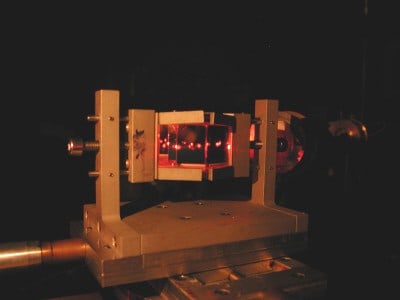Physicists in the UK have discovered that thin films of silver -- a normally opaque material -- can be made highly transparent by sandwiching them bewteen zinc-selenide-coated glass blocks. Ian Hooper and colleagues at the University of Exeter say that the light passes through the silver a bit like the way particles can tunnel through barrriers. The work could help to improve the efficiency of organic light-emitting diodes and enable a new generation of semiconductor devices. Phys. Rev. Lett. 97 053902)

It is well known that light travelling through a solid block will undergo total internal reflection if it strikes the surface at a very shallow angle. Some of the electromagnetic field, however, strays into the air — a so-called evanescent wave. This can form a beam of lower intensity if it passes into another solid block placed nearby. Hooper and colleagues then wondered what happens if each block is coated with another material. According to their calculations, light should be transmitted with perfect efficiency.
To find out what happens in practice, the researchers coated the surface of a silica prism with a film of zinc sulphide just 200 nm thick. They then clamped two such prisms together, leaving a very thin air gap sandwiched between them. When light of the correct wavelength was used, it was found to pass through the sandwich with about 85% efficiency. This was not quite perfect transmission because the zinc sulphide absorbs some light.
The physicists then replaced the air gap with a 40-nm thick layer of silver. On its own, silver of this thickness is almost opaque to light. But when sandwiched between the two coated prisms in this way, it was found to transmit light with an efficiency as high as 35% at certain wavelengths.
According to the team, the light is transmitted because light reflected from the silica/zinc selenide and the zinc selenide/silver interfaces are 180 degrees out of phase with each other and of equal amplitude. They therefore cancel out to give no net reflection – that is, all the light is transmitted. “The reflection from the front interface combined with the multiple reflections from the subsequent interfaces also interfere such that they cancel,” says Hooper. With no net reflection, and with a non-absorbing system, all the light must be transmitted.”
The researchers say their technique could be used to improve the efficiency of a new generation of “top emitting” OLEDs, whose performance is limited by the light passing through a metal cathode. It could also be used to improve semiconductor devices, where an analogous quantum effect should be seen. Here, semiconductors could be layered together to create a barrier through which a current could tunnel with less loss.



